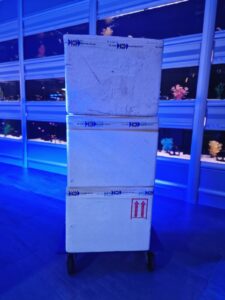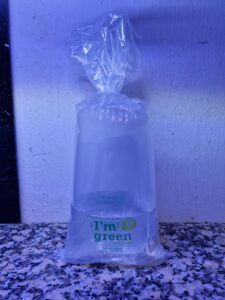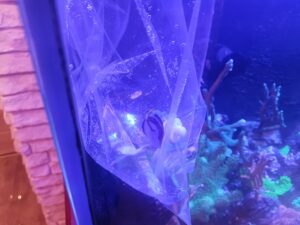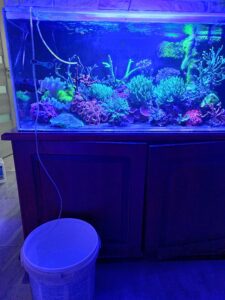Table of Contents
Introduction
Having a marine aquarium is a fascinating and rewarding hobby that allows you to observe the beauty of the underwater marine world in the comfort of your own home. Once the tank maturation phase is complete, and your aquarium has reached stable conditions, the time comes for one of the most exciting moments—purchasing fish and introducing them to your marine ecosystem. However, it’s important to remember that the process doesn’t end with the purchase itself. A very important step is the proper acclimatization of the fish, which is a mandatory and necessary activity.
Why is acclimatization so important?
Marine fish are extremely sensitive to changes in water parameters, such as temperature, salinity, and pH. A sudden change in these parameters can lead to stress, illness, or even death of the fish. Therefore, acclimatization, the process of gradually adapting the fish to new water conditions, is essential to reduce the risk of osmotic shock and ensure the new inhabitants of the aquarium have the best, least stressful start in their new environment. Before introducing newly purchased fish into the main tank, it is recommended to conduct a quarantine. This can be done in a separate aquarium equipped with light, necessary filtration, and heating. The quarantine process should last no less than 2 weeks. During this time, observe the fish’s behavior and check for any signs of illness. If treatment is necessary, performing it in the main (target) tank could result in the death of the organisms living there.
Steps of marine fish acclimatization
- Transport
After purchasing the fish, it is very important to get them home as quickly as possible. Fish should be transported in a shaded place to minimize the stress associated with the change of environment. Styrofoam boxes are ideal as they provide shaded conditions and limit the influence of external temperature. At home, prepare an appropriate place for acclimatization—this can be a plastic container or the bag in which the fish were transported.
- Slow temperature equalization
Once you arrive home, place the bag with the fish in the aquarium but do not open it immediately. Allow the temperature of the water in the bag to slowly equalize with the temperature of the water in the aquarium. This usually takes about 20-30 minutes. Attach the bag to the edge of the aquarium with a clip, avoiding areas with strong water flow. Also, remember to turn off the light or reduce its intensity during this time to avoid further stressing the fish. - Acclimatization
Marine fish acclimatization is a crucial process that allows new aquarium inhabitants to safely adapt to their new environment. There are two popular acclimatization methods: the floating method and the drip method. Each has its specific application depending on the type of fish and their sensitivity to environmental changes.
- Floating method
This method is usually used for more resilient, less demanding aquarium fish and is also less time-consuming.
In this method, after the bag with the fish has been placed in the aquarium for about 20-30 minutes to equalize the temperature, you can proceed to the next steps of acclimatization:
- Adding aquarium water
After the temperature has equalized, open the bag and begin gradually adding aquarium water. Every 5 minutes, add about ¼ cup of aquarium water to the bag until it is nearly full. - Draining the bag
Once the bag is full, carefully drain about half of its contents into a container or bucket. It is important never to pour this water into the aquarium, as it may contain contaminants or pathogens. - Continuing acclimatization
After draining half of the water, continue adding aquarium water to the bag at 5-minute intervals, adding about ¼ cup each time. This process can be repeated until the water parameters in the bag are close to those in the aquarium (especially salinity and pH). - Transferring fish to the aquarium
After completing the acclimatization, the fish can be carefully transferred to the aquarium, avoiding pouring the water from the bag into the tank. It is best to use a net to catch the fish. Fish should be introduced preferably with the lights off to minimize their stress. Observe the fish for the next few hours to ensure they are adapting well to their new environment.
- Adding aquarium water
- Drip method
This method involves slowly mixing aquarium water with the transport water in which the new fish are located. This method is more complicated and recommended for more demanding fish that are sensitive to changes in water parameters, such as salinity, pH, and temperature. This process minimizes stress and the risk of osmotic shock, which can result from a sudden change in water parameters. Undoubtedly, this method is more time-consuming than the floating method. To use this acclimatization method, you will need a bucket and an air hose. In this method, after the bag with the fish has been placed in the aquarium for about 20-30 minutes to equalize the temperature, you can proceed to the next steps of acclimatization:
- Preparation
Place the fish along with the transport water in a bucket. It is important that the bucket is large enough to accommodate the fish and additional water from the aquarium. Also, the water level in the bucket after pouring in the transport water must cover each fish. - Starting the drip
Using an aquarium air hose, place one end in the target tank, where the fish will be introduced, and the other end in the bucket with the transport water and fish. Then set the water flow from the aquarium to the bucket at a rate of 2-4 drops per second. A clamp, air pump valve, or a simple loop made of string can be used to regulate this flow. - Acclimatization
As the water in the bucket doubles in volume compared to the base (transport) water, drain 50% of the water from the bucket but remember never to pour this water into the target aquarium. After the water volume doubles again, check the temperature, salinity, and pH parameters. If these parameters differ from those in the tank where the fish are to be introduced, drain 50% of the water again and repeat the dripping process until the water volume doubles. Repeat these steps until the parameters are consistent, and then you can complete the acclimatization. - Transferring fish to the aquarium
After completing the acclimatization, gently transfer the fish to the aquarium using a net. It is best to introduce the fish to the tank with the lights off, which will reduce the amount of stress for the new inhabitants of your aquarium. Observe the fish for the next few hours to ensure they are adapting well to their new environment.
- Preparation
IMPORTANT: If you plan to purchase fish and thus carry out the acclimatization process, prepare an appropriate amount of saltwater, which will be used to replenish the water taken from the tank where you will introduce the newly acquired fish for this process.
Summary
As you now know, acclimatization can be done using the floating method, which is faster and easier and recommended for less demanding fish that are not as sensitive to environmental changes. The drip method, though more time-consuming, provides a safe adaptation to new conditions for more sensitive fish that require special attention when being introduced to a new environment. The choice of the appropriate method depends on the specific needs of the fish and their sensitivity to changes in water parameters. 
Proper acclimatization of marine fish is a key element that can determine the success or failure of keeping these fascinating animals. Ensuring the fish undergo the proper adaptation process minimizes stress and reduces the risk of health problems. Remember that patience and accuracy in acclimatization are investments in the health of your marine pets, which will certainly translate into long-term satisfaction from maintaining a marine aquarium.
About the author

Grzegorz Bubak
My fascination with marine aquariums began over two decades ago when I stumbled upon an article about this topic in a magazine. Since then, the underwater world has become my obsession and passion, shaping my everyday life. I started my adventure with marine aquariums with soft corals, which were my first step into this fascinating world. Over time, captivated by the diversity and beauty of SPS corals, I decided to focus on their cultivation, which continues to fill me with constant wonder.
Thanks to my experience and passion for marine aquariums, I am ready to share my knowledge and expertise with other enthusiasts in this field. I am happy to be part of the Reef Pedia community, which serves as an invaluable source of information for all marine aquarium lovers.




